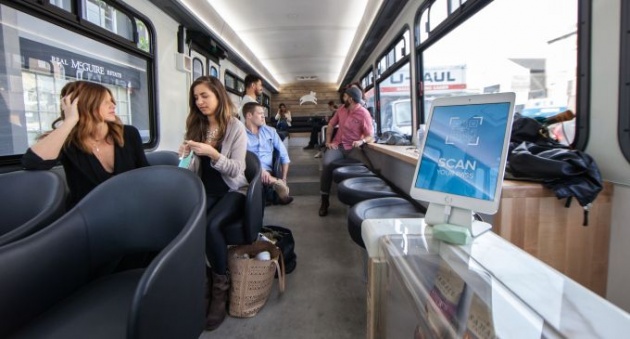
Transit startup Leap is finally launching in San Francisco with completely overhauled buses and a route from the Marina to the downtown area.
The startup, which is trying to rethink mass transit, is competing with a host of other shared transit companies from Y Combinator-backed Chariot to ride-pooling startup Loup and, of course, Uber and Lyft.
Leap, however, is aimed at regular commuters who are doing a predictable route every day and may not want to jump for the price points of on-demand services like UberPool and Lyft Line. Tickets cost $6 individually or $5 in packs of 20. If you use commuter benefits, you can get the cost down to $4 a ride, according to co-founder Kyle Kirchhoff.
The buses circulate every 10 to 15 minutes and take about 25 minutes to go from one end of the line on Lombard Street to the other end in the Downtown area. The service runs during peak commute hours from 7 a.m. to 10 a.m. and 5 p.m. to 8 p.m.
The key differentiator from other bus startups like Chariot is how Leap has rethought the entire internal experience of the bus. They bought old NABI buses and refurbished them with plush interior seating, Wi-Fi, USB ports and bar stools for working on laptops. They run on natural gas.
“We’re really building an entirely different experience inside. Every single material in this bus was really thought through,” Kirchhoff said. “This is kind of a blend between a coffee shop, a workspace and something that feels like your living room.”
The on-boarding process uses a quick QR code scan on an iPhone or an Android device, or if you have Bluetooth enabled, it will do it automatically. If you don’t have a smartphone, you can print paper passes. The same apps can also be used to purchase food and drinks from Blue Bottle Coffee to Happy Moose Juice. There’s an opt-in part of the app where you can choose to share a little bit of information about yourself and learn about who is riding along with you.

They also give live updates on where buses are along the route and how many seats are left. Leap doesn’t use any existing MUNI stops and consulted with the San Francisco MTA about designing routes that would not interfere with public transit. Leap buses are not also currently accessible to wheelchair-using or disabled passengers, but Kirchhoff plans to add that in future buses.
“San Francisco faces some very real challenges. Taxis are impossible to hail. Private car services are extremely expensive at peak times,” Kirchhoff said. “We built something with an eye to complement the overall system.”
It is, of course, a politically sensitive time to be launching anything in San Francisco around buses, given the Google bus blockades from the last year.
But there is historical precedent in the city for a mix of both public and private solutions to transit. Many of the city’s older streetcar lines were originally created by entrepreneurs in the late 1800s or early 20th century, then were later purchased and absorbed into MUNI after the emergence of the private automobile challenged their financial viability. Then, private jitney services ran through the city for about 60 years, covering inter-city transit gaps that were later addressed by the regional BART system.
Some critics have raised worries that these bus startups, like Chariot and competitor Leap Transit, will cause the broader public to disinvest in the city’s municipal transit system. (Back in the 1970s, the city actually stopped issuing jitney licenses and voters backed a ballot initiative protecting MUNI on this very concern.)
But at this point, MUNI handles 700,000 passenger boardings per day. Leap is running four buses, with one in reserve, and probably handling fewer than 1,000 people per day. Political support for mass transit also continues to be pretty strong, with the city voters passing a $500 million bond for transit last year. Notably, it was the first bond supporting MUNI that the city was able to pass in nearly 70 years. The region’s political leaders are also starting to seriously discuss a second Transbay Tube for BART, which will ease overcrowding to the East Bay but will probably take several decades to build.
“We take a really long-term view of this thing,” Kirchhoff said. “There’s a sort of invisible boundary if part of a city is not accessible to transit.”
Leap is backed with $2.5 million from Andreessen Horowitz, Index Ventures, Slow Ventures and Salesforce CEO Marc Benioff.



